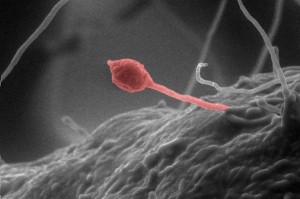Nov
11
It’s A Race!
November 11, 2008 | Leave a Comment
“We put a lot of pressure on them to be out there first,” said Peder Holk Nielsen, head of Novozymes‘s enzymes unit. “This is one of our must-win battles.”
The enzyme business surely sees the coming technologies using heat such as gasification and Fischer-Tropsch units to convert biomass to fuels. Novozymes is also joining the race to use another plant form, fungus to compete with enzymes and yeasts or bacteria to ferment or excrete hydrocarbon or alcohol products.
The Danish company’s scientists in China, Brazil, Denmark and the U.S. are testing mushrooms and lichen to find one that will turn corncobs and sugarcane stalks into biofuel. An affordable alternative to gasoline made from plant waste would end concerns that global hunger for energy is driving up food prices worldwide. Novozymes said it would find the answer by 2010, getting to the market before its closest rival, Danisco A/S.
Fungi like mushrooms and lichen make enzymes to eat rotting logs and decaying leaves. Biofuel producers use the enzyme proteins to break down the complex carbohydrates in plant cells into a soup- like mixture of simple sugars that yeast can eat. Then in a process much like making beer, yeast ferments the mixture, producing ethanol. Enzymes now on the market can’t break down the tougher parts of plants, the cellulose, effectively enough to be affordable.
So last May, Novozymes’ microbiologist Wenping Wu led scientists across farms in northeast China, searching through piles of decaying corn stalks for new strains of fungi. The search is daunting because of the sheer numbers of fungi. Researchers have amassed 480,264 different kinds and say as many as 1.5 million species may exist. Each specializes in feeding at specific points in the cycle of decay, and can have anywhere from two to 100 different enzymes. Some fungi grow worldwide, while factors such as temperature, soil type, and altitude limit others.
But scientists are running up against plants’ natural defenses. Lignin, found in corn’s stalks and leaves, is made up of the toughest tight-knit cells in the plant, because it’s designed to protect the seeds for reproduction and to resist invasion from, among other things, fungi.
So its of great surprise and some consternation that a team led by a Montana State University professor Gary Strobel has found a fungus that produces a new type of diesel fuel, which they say holds great promise. Direct from biomass to fuel product Strobel calls the fuel output “Myco-Diesel.”
Now there’s an “Oh my God” sort of moment for you. Even more alarming since it’s a race, is Strobel has some experience in this kind of thing; he is the discoverer of the fungus that contains the anticancer drug Taxol.
Strobel travels the world looking for exotic plants that may contain beneficial microbes, found the diesel-producing fungus in a Patagonia rainforest in 2002. That visit yielded a collection of a variety of specimens, including the branches from an ancient family of trees known as “ulmo.” When he and his collaborators examined the branches, they found fungus growing inside. They continued to investigate and discovered that the fungus, called “Gliocladium roseum,” was producing gases. Further testing showed that the fungus — under limited oxygen — was producing a number of compounds normally associated with diesel fuel.
“These are the first organisms that have been found that make many of the ingredients of diesel,” Strobel said. “This is a major discovery.” A paper about the fungus is in Microbiology. What’s exciting about the Gliocladium roseum fungus, however, is that it can both break down cellulose and synthesize the liquid fuel. “A step in the production process could be skipped,” Strobel said in a press release.
Strobel doesn’t know when drivers will fill their gas tanks with fungi fuel or if processors can make enough to fill the demand. The road to commercialization is filled with potential glitches, he said. It’s also a major endeavor that will be left to others who specialize in those areas.
Strobel’s son Scott Strobel at Yale University is already screening the fungus genome. Gary Strobel said, “The main value of this discovery may not be the organism itself, but may be the genes responsible for the production of these gases. There are certain enzymes that are responsible for the conversion of substrates such as cellulose to myco-diesel.”
Scott Strobel in his turn said, “”The broader question is, what is responsible for the production of these compounds. If you can identify that, you can hopefully scale it up so you end up with better efficiency of production.” Add to that the promising aspect that the fungus can grow in cellulose. “That’s the most common organic molecule on earth. It’s all around us, everywhere.”
There’s nothing in the scientific literature about a microbe that produces the diversity of medium-chain hydrocarbons found in the “Gliocladium roseum,” Scott said. Longer hydrocarbon chains are common, but “that’s not what you put in your gas tank or jet engine.”
Scientists in a variety of disciplines should be able to work together to optimize production and find a way to turn what is essentially a vapor into a burnable, liquid fuel, he added.
Just get to methane; basic natural gas guys, and the biggest problems of the future are solved.
Wow. It’s a race all right.


